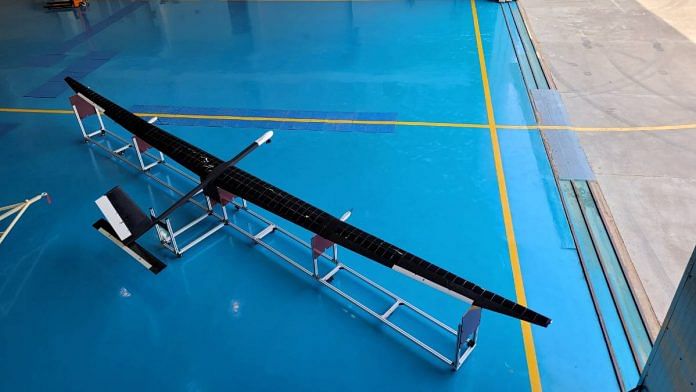New Delhi: From carrying out under-the-radar border surveillance, to improving internet access to remote corners of the country, the Council of Scientific and Industrial Research-National Aerospace Laboratories’ (CSIR-NAL’s) futuristic solar-powered unmanned aerial vehicle (UAV) could soon make India one of the few elite nations to have its own High Altitude Platforms (HAP).
At the Wings India 2022 civil aviation event held last month in Hyderabad, NAL demonstrated a functional, sub-scale model of the HAP — an unmanned flying vehicle that runs on solar power during the day and high-density lithium ion batteries at night.
The lightweight UAV is capable of flying at heights of over 22 kilometres, for up to 90 days, with payloads of over 16 to 20 kilograms.
Speaking to ThePrint, Jitendra Jadhav, Director of NAL, explained that the HAP will work as a pseudo satellite for telecommunication applications in the 5G & 6G spectrum.
“As much as 40 per cent of rural India still does not have access to high speed internet,” Jadhav said. “The HAP provides a low cost alternative to launching satellites or setting up towers,” he said.
He added: “The vehicle can be relaunched after 90 days.”
Act as ‘pseudo satellite’
Jadhav explained that the Indian security agencies needed a vehicle that can penetrate border areas, while flying under the enemies’ radar. “HAP can carry multi-spectral cameras to carry out surveillance and reconnaissance missions,” he said.
However, for Jadhav the more important application is the vehicle’s capability to act as a ‘pseudo satellite’.
“The vehicle can carry a communication antenna. With these satellites, high speed communication can be made available, as far as Havelock Island,” Jadhav said.
He added that HAP will have advantages like low data latency, high bandwidth, the flexibility of launch and low cost. The HAP can also be used for earth observation, climate research.
Lithium batteries a challenge
Jadhav said that while the vehicle was designed using a light-weight composite metal, it’s large wingspan posed the challenge of maintaining stability while in flight,
For this, NAL developed a control system that keeps the UAV stable. Apart from this NAL also developed a technology to allow them to embed thin solar panels onto the wings of the craft.
NAL now plans to carry out flight runs with the subscale model of the HAP by September this year, to collect more data on its performance. These trial runs will allow the team to iron out remaining glitches of the system, so that eventually a proof of concept can be launched by 2023.
Jadhav said that one of the remaining challenges for the system is the high-density lithium ion batteries. “Currently these batteries are being imported. However, NAL is working on developing these in India.”
(Edited by Poulomi Banerjee)
Also read: The ‘make in India’ dream of an IIT-Delhi startup whose drones lit up sky at Beating the Retreat






